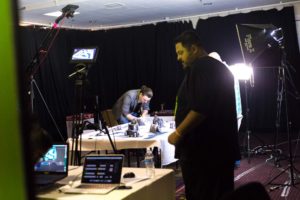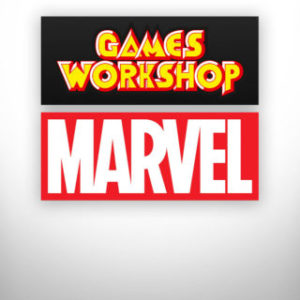Hey everyone, Danny from TFG Radio here, and today, I ain’t talking Knights or Nids, but rather, this is more a reflection on the recent tides in the sea of Games Workshop. The internet is thing I hear, which should not be surprising to me as I write on it constantly, but lately, it seems more and more, streaming dominates the conversation around 40K, and people try to make 40K something like an e-sport, and that gets me wondering, why?
We live in exciting times when it comes to 40K. GW is active in our lives, we are getting more rules than we know what to do with, and well, the models are gorgeous as always and they keep getting better. Tournaments are exploding, and if you were around 10 years ago, the very thought that there would be competing GT and Major level events just about every weekend across the world would sound like a fairy tale. Here we are, and what’s more, thanks to the magic of the internet, you don’t even have to leave home to play Watch-Hammer.
I love Watch-Hammer, and I have definitely spent a night at the game store just watching games, long after mine was over. Hell, I usually play armies that win or lose fast, just so I have more time for Watch-Hammer when I go to a tournament. I started in judging and being a TO because I was so good at Watch-Hammer, and I learned a bunch of rules and such. The thing is, online 40K is not the same thing, and while you can scratch the itch that way, it is not the same, not yet.
The problem here is that there are some who want to make 40K a professional E-sport without understanding how to do that effectively and without a realistic understanding of how the E-sport model works. On a basic level, to host a successful e-sport event, your revenue is generated not through the participants (the very idea that a professional Overwatch or Starcraft team would pay money to compete is ludicrous at this point), but rather advertisements and subscriptions. League of Legends can give out thousands upon thousands of dollars because they are getting millions of views on Twitch, which is a whole lot of subscription and advertising dollars. LVO 2019 was the most watched Warhammer event ever, with 15,000 concurrent viewers (CCV) at its height. Yes, 15,000.
Now that’s a lot, and anybody in the Podcast or streaming game right now would kill for those numbers, but in the world of e-sports, that is not even on the radar. An event with less than a million views? That’s a failure. While the Warhammer economy and the E-sport economy are at different stages, the reality is that if you want Warhammer to be a successful e-sport, you need a large, active audience, and we don’t have that yet.
Part of this is just a simple truth: Warhammer is not that popular. Yes, 8th edition has brought a lot of people back and is has brought a lot of people in, but the reality is that there are certainly less than 5 million active customers of GW products, worldwide. That’s a pretty paltry number compared to the games that make up e-sports. To get to the level where streaming events and hosting events is profitable takes a game with a massive audience. To put it in perspective, in the E-sports world, Overwatch has been in a bit of decline where 154K* concurrent viewers is a worrisome sign to some that the game is losing ground to all the other offerings. Just look at Twitch’s stats on Fortnite and how many damn people stream and watch that game. The difference is staggering, but those are the kind of numbers that you need to generate the revenue where you can have a truly professional league with professional players.
If you chase the subscription model, you either need to have a very, very large audience, or you need to charge quite a bit. While the average 40K player spends a good deal of money on the hobby, there is quite a difference between spending 50$ on a cool character model and spending 50$ on a digital subscription to watch battle reports, read articles, or listen to elite advice. Sure, some will spend that, but this is a small pool, and really, all the subscription hungry content creators out there are competing for the same people. A Patreon only goes so far, and again, the more content creators there are, the more competition there is for a limited pool of revenue, so this model isn’t sustainable save for a very, very select few who rise to the top. While specific personalities do dominate each game in an e-sport, each game still boasts dozens upon dozens of highly accomplished, elite players with their own patreons, endorsements, and channels, but this can happen with a pool of millions rather than a pool of maybe hundreds. There just isn’t an active, mobilized fanbase to truly support a vibrant “Pro” economy at the moment. The same voices as “Pro” create long-running echo chambers that stagnate the game and make the competitive nature of it less competitive as the competitive meta becomes influenced by a few individuals with outsized influence over perception of what is truly “good”.
Let’s also remember that we are talking about GW “customers”, not “players”. If you have ever run a game store or been connected deeply into one where you’ve had the advantage of seeing how the guardsmen are made, you know that there are plenty of people who buy models, paints, books, and rulebooks with no intention of ever playing the game. There is a whole population of GW customers who do not care at all about playing but rather love collecting models, building/painting, or simply love the fluff. Even GW’s most successful digital product, Dawn of War, sold roughly 4 million units, including expansions. That’s nothing to shake a stick at to be sure, but as many people can tell you, there are plenty of folk who have played Dawn of War but have never played nor want to play tabletop 40K.
There is also the simple truth that 40K is not a viewer-friendly game. I remember watching my first 40K game, and damn, was it beautiful. I got to see the models up close, look at how they were arrayed on the field, and watched as dice rolled and I had no idea what was happening. Thankfully, the two gentleman were nice enough to explain things in broad terms, but really, I didn’t get it. It took me a few years to get 40K to say the least, and by then, 2nd edition was 3rd, and well, I had to “get it” again. Now, despite my associates’ best attempts, I’ve never played Apex Legends before, but if I pull it up on Twitch, I can tell who is doing well and who isn’t because visually speaking, the game is obvious. My favorite analogy is golf: if you watch it on TV, even if you have no knowledge, if a person hits the ball far and the ball ends up close to the hole, you know that was probably pretty good. You can’t say that about 40K.
So this means you need a few mitigating factors to be viewer friendly. First, you need commentators, but that’s not as easy as giving a guy a mic. You need someone like Geoff, rest in power, who had a top-level understanding of the game but also had a charismatic, engaging personality. He was funny without sounding like he was trying, and he could tell you what was a good play and what was not, and he was right 99% of the time. You need that on the stream, a mix of acute understanding of the game and the ability to engage the audience while explaining it in a way that any level player could access. There are certainly some great streamers out there, but is there enough, and do they have the visibility to reach out beyond our small circle into the wider audience?
Next, you need logistical abilities to make use of the commentators. You need telestrators, so the commentators can highlight and circle key points. You need visually engaging but clear overlays that help display important information without cluttering the screen. You need proper lighting to make sure that models and dice facings are clear. You need multiple cameras to show different angles of the table as well as a roving camera that can pinpoint on important moments. We need to move beyond the crotch-shot angle and get camera equipment capable of giving you a player’s view of the table. You need high quality computers capable of running multiple systems at once. You need high quality mics and soundboards that make sure the background noise isn’t overwhelming, and that the commentators can be heard while also ensuring that the commentators are informed about the game. This means to either mic the players, and having someone running the soundboard, switching between players and commentators, or you need a person whose entire job is to convey information about the game to the commentators. You also need the staff to run these systems with the knowledge to do so effectively, and sound mixing, lighting, and cinematography are not skills you easily just “pick up”.

That’s doable today, and some streams have that, but even that isn’t truly enough. I’ve had friends who don’t play actually take the time to watch the streams since I am hovering around them judging or doing a guest-shoutcast, but again, they aren’t getting all they can out of the experience. The most common critique that I get is that they do not understand what is happening and why it is important. Part of this problem is that I cannot bring up 3 screens while commentating to show lists, rules, highlights, and all the other things that professional sports (including e-sports) do. I would love to have pre-taped explanations of say cover, or line of sight, or the difference between invulnerable saves and feel no pains, but we haven’t developed that library yet let alone the ability to seamlessly put it into our streams. All told, you need a large staff of highly knowledgeable people, and you need thousands of dollars of equipment to do this right.
Let’s not forget that this is a live game, not a computer controlled one, so mistakes happen, and bad actors have much more room to abuse the system. This means you need good judges to keep control of the game, and we as community need to expel the bad actors. There is a reason that “competitive” 40k gets a bad reputation from casual players: because if you have a memory longer than 2 years, some of the same names and same behaviors pop up all the damn time, and nobody does anything about it. If we want to be able to appeal to a wider audience, it needs to be clear that games are well-run and people who would take advantage of the social aspect of this game are not tolerated. A prime example of this is the viral (by 40K’s humble standard at just shy of 75K views) video “My Opponent’s Yellow Card”, which hit a nerve with a lot of people because issues of sportsmanship and cheating is something that far more than just “competitive” 40K players have strong feelings about. I doubt a video that features the top 10 ITC players all sharing their deepest tek for free would hit the same level of views simply because most players don’t care about that, but many, many players are about the social aspect of this game.
The game mechanics itself does not lend itself to TV as well, the game is boring sometimes. A movement phase can take 10-15 minutes, and yes, movement is the most important phase in the game, but the average viewer does not want to hear a treatise on why positioning one model in a unit is so key to victory. The average viewer wants to see things blow up and dice being rolled. Having pre-taped highlights of other games or the ability to switch to other games with more action is certainly a necessity. If you look at the popular e-sports games, they are action based because the average person just wants action, not a discussion of team meta. The game also has to be visually dynamic. I am sure Marathon (look it up, youngsters) would be a fine streaming game except it looks like garbage today. Boring boards and/or boring armies are not going to get someone to sit and watch. This is a visual, aesthetic experience, just like every other video game, and you cannot escape that. If so, we’d all be playing Risk by email instead.
Now, I suppose if we assembled a dream team of 40K personalities and pooled our collective resources, we could put on a hell of a show, but then the problem again becomes, to what end? The audience isn’t there yet, and so you are in the pickle: do you invest thousands of dollars to have the technical ability to reach a wider audience in the hope that you build the audience you need or do you wait and hope the audience appears? GW can do the first because they are a multi-national company, but what about the rest of us?
Let’s say that GW was willing to invest as much as it took, and we suddenly had a truly professional setup (we are talking ESPN level, but they have already committed quite a bit, so let’s be thankful on that end) where we had all the tools at our disposal, we still need the audience, and the reality is that the audience isn’t there. This is because competitive 40K does not appeal to the majority of GW customers. You know what does? Ultra-cool looking armies on ultra-cool looking tables where the games are fun, crazy things happen, and in general, the spirit of the fluff is presented. As any successful TO will tell you: the big names may drive some internet discussion and get some downloads on the podcasts, but who pays for the hall, the terrain, and everything else are the guys and gals that want to roll dice, have a few laughs, and play new people and new armies for the weekend. Plenty of “competitive” players malign casual fans of the hobby, but the vast majority of these competitive types don’t run events and don’t understand that you can have the top 20 of the ITC all show up to an event, but if they are the only ones, unless it is a local store, you are going to lose a lot of money.
That’s the lifeblood of this hobby and this game: people with no interest in winning “best of”, and people who don’t see this as a sport but as a hobby, something you do to have fun and enjoy life, not something you need to excel at in which to feel good. For every Try-Hard, there are a dozen folk who just want to have fun and enjoy the hobby. 40K and other tabletop games do not have the broad, general appeal of video games because they are a tactile, intellectual, social, and artistic experience. The Hobby takes a certain level of dedication, and it is not a cheap, quick-fix distraction like most video games. Most people play this game because it is fun, but that fun is centered around doing it, being there, being part of the experience itself, not watching the experience removed from it.
I often think back to what hooked me into this world, and it wasn’t 40K, it was Fantasy. It was my first game where all my models were built, my lizards were terribly painted, but I got to hold what took me hours to make, and I got to play a game where my opponent was funny, helpful, and shared a love of the lore. That’s what made me want to keep playing even though I got stomped. That experience does not translate through a screen. Maybe it will someday, but right now, not so much.
So, streaming and the ultra-competitive edge of 40K has nowhere near the audience required to really sustain a professional league let alone have room in the market for a series of professional players. Does that mean we should stop? Hell no. It means we need to adjust what we think streaming means, and how we think we can move forward.
As time goes on, we will have more and more commentators and streamers who can bring the energy. The technology to do what we need to do to make the game accessible to anyone will be more available. As 8th edition continues, we’ll get more and more players, and GW is clearly dedicating resources to expand its brand appeal to a wider audience (hi, Marvel!), and it is a snowball. The more players we get, the more access to the others we get, so patience. Let’s not try to speed 40K into something that it isn’t ready to be.
And let’s think about who we stream. While yes, some are going to want to see the very best against the very best, but more people are going to want to see two players with two gorgeous armies that are going to have a good time. The only stream games that I’ve seen non-players really stop to watch is when everyone is laughing, and it is clear that what they are doing is fun. Let’s also think about who we venerate. Sean Nayden and Jim Vesal are great ambassadors of this game because their armies are gorgeous and they play at the highest level. The ITC Hobby Track is a great example of trying to include the largest portion of the fandom and value their accomplishments. Maybe Renaissance Man is the most prestigious prize rather than just best overall? Let’s see more of that, and let’s encourage streaming games to feature a certain quality of army rather than just the name attached to it. A good middle ground is to stream 2 games at once, one competitive minded and one narrative minded, and by switching back and forth in a single stream, you can engage a wider audience.
Streaming is the future, and I don’t disagree, but trying to make 40K an e-sport before it has the infrastructure and audience necessary to support that is folly, and the best way to build an audience is not to present to them the most “competitive games”, because that’s not what makes this hobby worth doing, it is to present to them the sheer joy and fulfillment one can have by playing this game with good folk, with good models, on good tables, and having good times.
And remember, Frontline Gaming sells gaming products at a discount, every day in their webcart!











That’s one of the best articles I’ve ever read on the internet showing the difference between reality and truth of becoming a full-time, professional “personality” of a GW game.
10K played in ITC last year … 1.5K was the best streaming figure … around 5 million different people are involved in the hobby (taking the sales figures – GW always asks for a post code for each receipt, even if buying instore.)
As a plastic model hobby, GW is big compared to airfix, revell etc who have been in serious decline for 30+ years. But that’s only a fraction of the millions playing Fortnite .. and also why GW won’t see a million pound prize fund which is common in big video games.
And a major technical issue is the players POV .. the GW overhead shoots are hard to follow but at least stop from distracting competitors.
12k played in the ITC last year, there were actually more like 15k concurrent watching the final game (I think that was a typo) and there are around 2 million active GW hobbyists from all of the data available online. I could believe 5 million total customers have bought something once or whatever in the past X years, but all the data we see is that that doesn’t reflect the number of people actively involved in the GW hobby.
Although, yes, we are a long way away from anything like League or whatever. But, these are exciting times as GW is actively going out and expanding their customer base. I think we will see a lot more hobbyists becoming much more active in the not distant future and the environment will change quite a bit.
YES YES A THOUSAND TIMES YES!
This article lists EXACTLY what would make a fantastic streaming experience, and then, rightly, points out exactly why we’re just not really capable of getting there – yet. I feel like I could give great commentary, but I don’t have the skills or funding to take on something that I would be happy with. You’re 100% correct; you need good angles to change views on to give an impression of motion. You need whiteboard tech to have commentators draw on and show how units moving around and the removal of casualties is causing big changes in the game.
That’s the hardest part about streaming 40k – the game is big, but the action is small. For those who know and are in it, that small action feels huge, but for those watching it, it remains small. It’s why we learned that a camera on a dice box is a helpful feature – it makes that small part feel big – but you really do need more. A good announcer also has to be able to fill in the MASSIVE dead-spaces. Starcraft commentators like the incredible Geoff Robinson, rest in power (I love that for him, btw – good idea!), know that the start of a Starcraft match is pretty uneventful and uninteresting. The game takes at least 3 minutes for even the fastest rush to really start in earnest. Commentators have to fill those 3 minutes. 40k is even worse for that, as there’s tons of dead space time where a player is just thinking, executing mechanical play (okay, how many guardsmen do my guardsmen kill? okay, next squad. okay, next squad…), or just waiting on a judge or precisely where to place or orient a model. You need to fill that.
Thank you for this article. I’ve dreamed about what it would take to make a really perfect 40k viewing experience, and you’ve summed it up here. If anyone asks again, I’m going to link them back to this article. In the meantime, I have a new task – dreaming up how to bridge this gap in a cost-effective manner!
Quick correction, Danny (loved the article) we had 13,000 to 15,000 concurrent during the 40k champs finals, and over 100,000 unique for LVO. However, your point stands.
15,000 was the intended number, not 1500. It was a typo, and I apologize for such.
All good, brother =)
Where is my ability to post my popcorn eating gif when I really want it!?
I wonder if there’s a WordPress plug-in to allow Gifs in the comments section?
FIND OUT! I would be happy with just a photo option for muh memes. Then again, maybe not open that particular pandora’s box…
Lol, Pandora’s Box!
“You need multiple cameras to show different angles of the table as well as a roving camera that can pinpoint on important moments.”
This is key, and I’d like to add that the topdown camera angle is unnecessary as soon as a proper roving camera is implemented. Despite covering the entire table it doesn’t contribute to a better understanding of the overall situation for three reasons. First, it is difficult to identify some models from above, especially if they make up less than 0.1% of the image. Second, it makes it hard get a sense for the height dimension of the game in regards to terrain, line of sight etc. Third and most important is that the game is best contextualized by focusing on the models involved in the current event of the sequence – an overall situational awareness will be a natural byproduct.
Of course the main advantage is that it’s easy to implement since you only need a single camera and no operator, but beyond that it could be removed.
Awesome Article. Spot on.
Thinking about the camera angles and the like, perhaps some cameras that are mounted in terrain or right on the board edges would be neat. Able to show a ‘models’s eye view’ of the game. Capture that poor fire warrior’s perspective as the Greater Deamon has now moved around the side of the building and is staring him down.
I think there is absolutely the possibility of 40K going ‘pro’ and would love it. Just going to need a lot of work to get it there
Taking off from one of your tangents, yeah, Marathon would be an awesome streaming game if it had modern graphics.
I also think you could get some pretty entertaining material by just getting a group of serious Marathon fans together and having them argue about what the storyline actually was XD
YouTube’s “Play On Tabletop” channel is doing an amazing job with their 40k in 30M segments. Beautiful Armies, Beautiful Terrain, Good Narration and Amazing Studio quality camera, sound, lighting work.
Top down streaming of 3 hour games is tough to watch and boring at its best. Geoff and Frankie’s commentary and the Twitch stream chat were the only things that kept it entertaining. As I strained to even figure out what the different blobs of color on the large confusing boards were even doing. (yep I’m a noob struggling to get into 40k learning what I can from various streams and podcasts. No shame)
Warcry and Kill Team are both visually easier to understand on a smaller board and the games are a lot shorter. They don’t have the wider appeal of their Big Brothers but from the outside looking in aspect they could capture more peoples attention.
You need to check out Killteamstream.com coverage of the Kill Team event at SoCal Oct.26th & 27th, he has a great setup and will have good commentators following the action. Obviously most people reading this will be more interested in the FLG stream but during the slow moments pop on over and give us a view.
Thanks Zapntoo! Catching one of those reports right now. So far looks great!